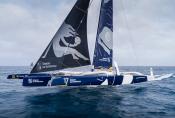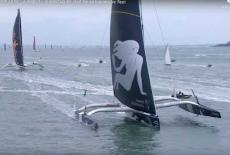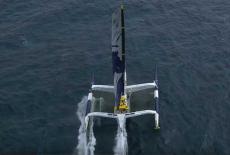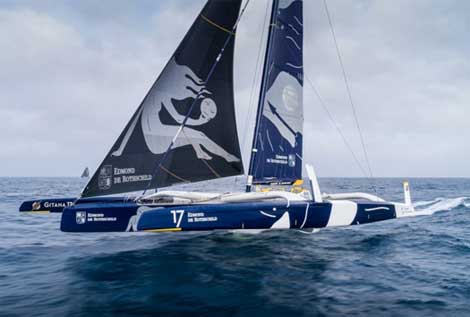Fastnet 2019 - Record 603 Miles in 28 Hours

04.08.2019

Maxi Edmond de Rothschild Wins Fastnet & Breaks Record
A record fleet of 388 yachts set off on the 2019 Rolex Fastnet Race on 3 August. Organised by the Royal Ocean Racing Club (RORC) the non-stop race course covers 603 miles.
The 32 metre long Ultim trimarans laid on a spectacular finish resulting in ‘MACIF’, the leader since rounding the Fastnet Rock, being beaten to the finish line in the last breath of the race by her arch-rival ‘Maxi Edmond de Rothschild’.
For ‘Maxi Edmond de Rothschild’, their race had incidents. They went aground on the Shingles Bank at 25 knots while leading the Ultims out of the Solent destroying the tip of their daggerboard. Then a large fish got caught around their daggerboard just after passing the Fastnet Rock, requiring them to back down to extract themselves, allowing MACIF past.
The two giant Ultim trimarans, ‘MACIF’ and ‘Maxi Edmond de Rothschild’ were never more than four miles apart throughout the 48th Rolex Fastnet Race race. ‘Maxi Edmond de Rothschild’ set a new multihull record of 1 day 4 hours 2 minutes 26 seconds.
The Fastnet Race starts at Cowes on Saturday then heads down The Solent, towards Hurst Castle. Yachts then race as they head west in the English Channel, before rounding Lands End and heading across the Celtic Sea to round the Fastnet Rock off Ireland. The dramatic rock and lighthouse are the symbol turn mark of this epic race. Boats then sail around the Scilly Isles to the finish in Plymouth.
The Fastnet attracts both professional and amateur sailors onboard a diverse fleet, from some of the fastest racing machines on the planet to beautiful classic yachts. A traditional 30 foot yacht averaging 5 knots will take 5 days to complete the course.
The Fastnet Race, which has taken place biennially since 1925, was one of the earliest true tests of offshore sailing. It is legendary within the world of ocean racing. Flawless decision-making, determination and total commitment are the essential requirements as crews manage and anticipate the changing tidal and meteorological conditions imposed by the complex course.
The start of the Rolex Fastnet Race is from the Royal Yacht Squadron (RYS) line, Cowes, Isle of Wight. Yachts will race on a course of approx 603 miles (1,126 km) via the Fastnet Rock to the finish line at the western end of the breakwater in Plymouth.
Key features and distances:
Cowes – Needles: 16m
Needles – Portland Bill: 34m
Portland Bill – Start Point: 54m
Start Point – Lizard: 60m
Lizard – Lands End: 22m
Land's End – Fastnet: 170m
Fastnet – Scillies: 150m
Scillies – Lizard: 51m
Lizard – Plymouth: 46m
'Maxi Edmond de Rothschild' - part Boat and part Flying Craft
Designed by naval architect Guillaume Verdier and his team in collaboration with the Gitana design office, the Maxi Edmond de Rothschild will be part Archimedean boat (submerged hull), part flying craft. She is offshore racing’s first maxi-multihull designed to fly in the open ocean.
Designers say: The precursor of a new generation of giants of the seas, this boat features innovative, purposeful planing hulls beneath the waterline, which are a far cry from those used on the current fleet of oceanic multihulls.
Everything about the forms of the floats and the central hull shouts flight. She is equipped with the very latest architectural and technical advances in terms of appendages, with T-foil rudders and L-shaped foils measuring over 5.4m in height. With everything geared towards flight, a great deal of care has gone into the aerodynamics of the platform. The forms of the beams in particular testify to this, as does the integration of the living space/ cockpit between the two beams.
Going by the name 'Gitana 17', she has been devised, developed and built with the focus on solo sailing, but she will also be the ideal boat for major record attempts in crewed configuration.
Launched in July 2017, the construction of this multihull, which has already made her mark on the Gitana saga, required more than 170,000 man-hours, including 35,000 hours of studies.
All images are copyright RIB & HSC 2024 unless otherwise stated.
This does not exclude the owner's assertion of copyright over the material.
05.04.2024
Hydro Motion - H2 from NL to England in 2024
The TU Delft Hydro Motion Team wants to cross to…
05.01.2024
The Challenges of Unpredictable Marine Energy
From military to superyacht, it is clear there is an urgent…
Speed@Seawork 2024
Dates:
10th June 2024
Location:
Cowes, Isle Of Wight,
Foiling and Flying RIBs
Foiling powerboat designed to meet military needs - fast, stable, silent, fuel-saving. Collaboration by SEAir Foiling Systems and Sillinger RIBs.…
















